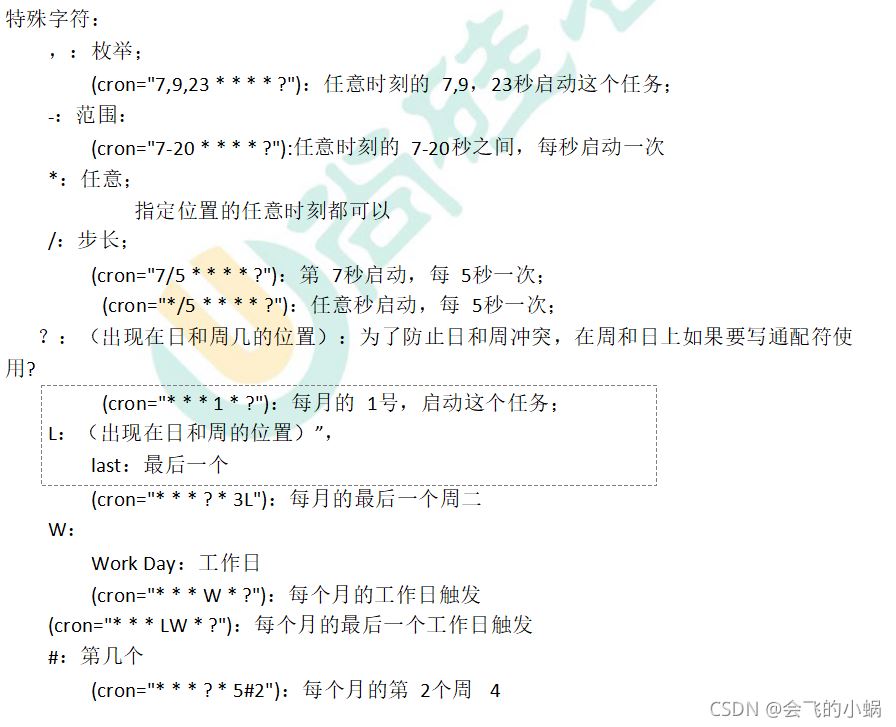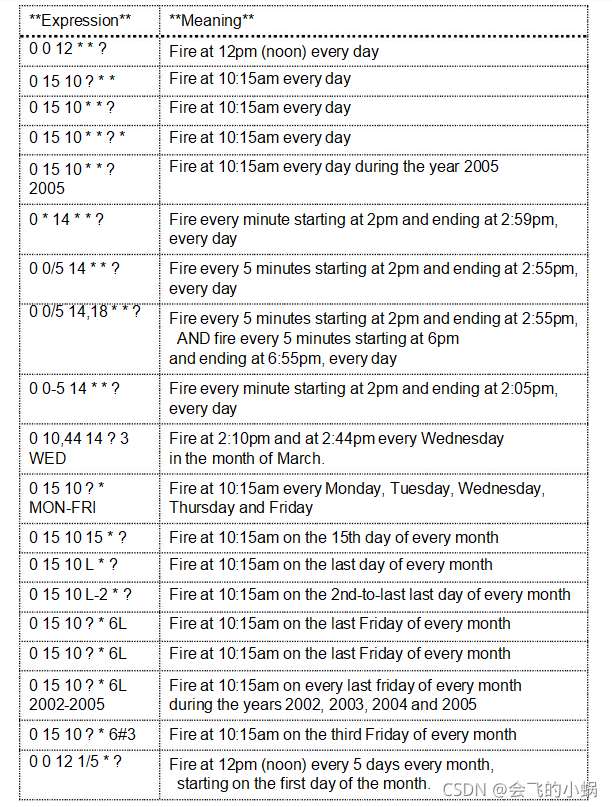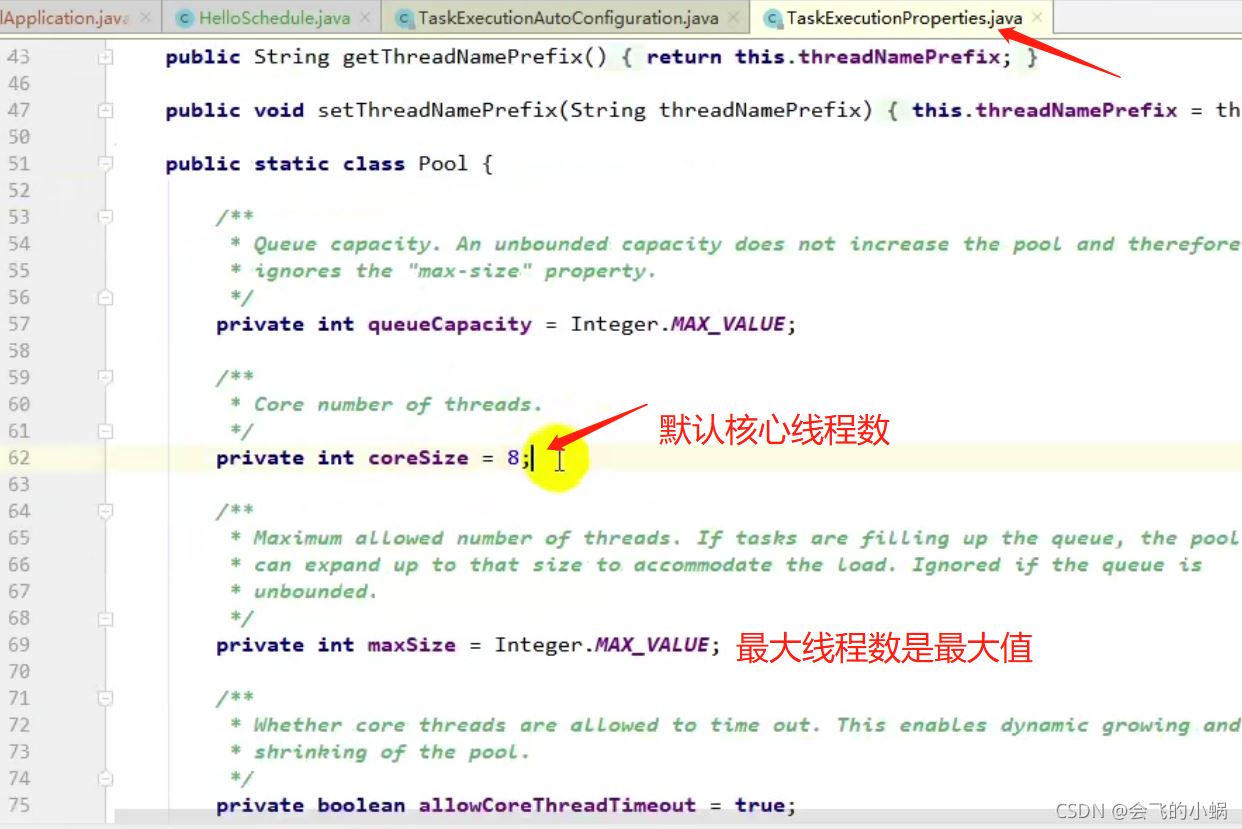这篇文章主要讲解了“如何理解Java spring定时任务”,文中的讲解内容简单清晰,易于学习与理解,下面请大家跟着小编的思路慢慢深入,一起来研究和学习“如何理解Java spring定时任务”吧!
一、定时任务
1、cron表达式
2、cron示例
3、SpringBoot整合
总结
语法:秒 分 时 日 月 周 年
(其中“年”Spring不支持,也就是说在spring定时任务中只能设置:秒 分 时 日 月 周)




@EnableScheduling
@Scheduled
实例:
package com.xunqi.gulimall.seckill.scheduled;
import lombok.extern.slf4j.Slf4j;
import org.springframework.scheduling.annotation.Async;
import org.springframework.scheduling.annotation.Scheduled;
import org.springframework.stereotype.Component;
import java.util.concurrent.TimeUnit;
/**
* @Description:
* @Created: with IntelliJ IDEA.
* @author: 夏沫止水
* @createTime: 2020-07-09 18:49
**/
/**
* 定时任务
* 1、@EnableScheduling 开启定时任务
* 2、@Scheduled开启一个定时任务
*
* 异步任务
* 1、@EnableAsync:开启异步任务
* 2、@Async:给希望异步执行的方法标注
*/
@Slf4j
@Component
@EnableScheduling
public class HelloScheduled {
/**
* 1、在Spring中表达式是6位组成,不允许第七位的年份
* 2、在周几的的位置,1-7代表周一到周日
* 3、定时任务不该阻塞。默认是阻塞的
* 1)、可以让业务以异步的方式,自己提交到线程池
* CompletableFuture.runAsync(() -> {
* },execute);
*
* 2)、支持定时任务线程池;设置 TaskSchedulingProperties
* spring.task.scheduling.pool.size: 5
*
* 3)、让定时任务异步执行
* 异步任务
*
* 解决:使用异步任务 + 定时任务来完成定时任务不阻塞的功能
*
*/
@Scheduled(cron = "*/1 * * * * ?")
public void hello() {
log.info("hello...");
try { TimeUnit.SECONDS.sleep(3); } catch (InterruptedException e) { e.printStackTrace(); }
}
}定时任务默认是阻塞的线程,也就是说即使你设置成每一秒执行一次,但是方法内部的业务时间需要5秒才能执行完,也会造成定时任务每6秒才能执行一次。
当然我们可以开启异步线程:
@EnableAsync
@Async
实例:
package com.xunqi.gulimall.seckill.scheduled;
import lombok.extern.slf4j.Slf4j;
import org.springframework.scheduling.annotation.Async;
import org.springframework.scheduling.annotation.Scheduled;
import org.springframework.stereotype.Component;
import java.util.concurrent.TimeUnit;
/**
* @Description:
* @Created: with IntelliJ IDEA.
* @author: 夏沫止水
* @createTime: 2020-07-09 18:49
**/
/**
* 定时任务
* 1、@EnableScheduling 开启定时任务
* 2、@Scheduled开启一个定时任务
*
* 异步任务
* 1、@EnableAsync:开启异步任务
* 2、@Async:给希望异步执行的方法标注
*/
@Slf4j
@Component
@EnableAsync
@EnableScheduling
public class HelloScheduled {
/**
* 1、在Spring中表达式是6位组成,不允许第七位的年份
* 2、在周几的的位置,1-7代表周一到周日
* 3、定时任务不该阻塞。默认是阻塞的
* 1)、可以让业务以异步的方式,自己提交到线程池
* CompletableFuture.runAsync(() -> {
* },execute);
*
* 2)、支持定时任务线程池;设置 TaskSchedulingProperties
* spring.task.scheduling.pool.size: 5
*
* 3)、让定时任务异步执行
* 异步任务
*
* 解决:使用异步任务 + 定时任务来完成定时任务不阻塞的功能
*
*/
@Async
@Scheduled(cron = "*/1 * * * * ?")
public void hello() {
log.info("hello...");
try { TimeUnit.SECONDS.sleep(3); } catch (InterruptedException e) { e.printStackTrace(); }
}
}这样就会开启异步线程,并且是非阻塞线程,因为每次都会开启一个线程来执行,我们可以看一下源码配置的截图,这个就是异步执行的默认配置,核心线程数是8,最大线程数是无限大,这时如果一直每秒执行一次,则会造成服务器资源耗尽。

当然,我们可以在配置文件中进行定时任务线程池的设定:
#核心线程数
spring.task.execution.pool.core-size=20
#最大线程数
spring.task.execution.pool.max-size=50
#队列大小
spring.task.execution.pool.queue-capacity=10000
感谢各位的阅读,以上就是“如何理解Java spring定时任务”的内容了,经过本文的学习后,相信大家对如何理解Java spring定时任务这一问题有了更深刻的体会,具体使用情况还需要大家实践验证。这里是亿速云,小编将为大家推送更多相关知识点的文章,欢迎关注!
免责声明:本站发布的内容(图片、视频和文字)以原创、转载和分享为主,文章观点不代表本网站立场,如果涉及侵权请联系站长邮箱:is@yisu.com进行举报,并提供相关证据,一经查实,将立刻删除涉嫌侵权内容。